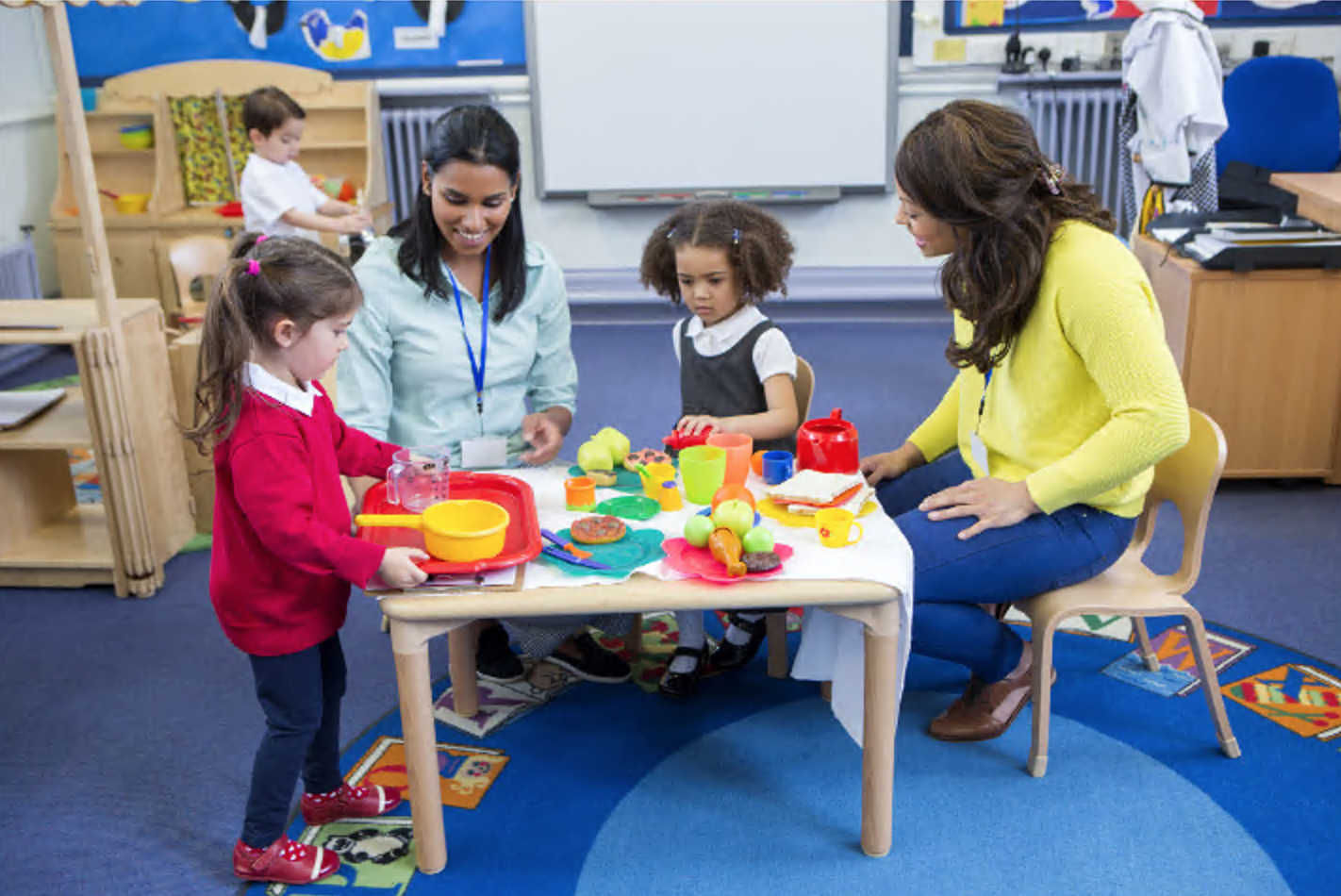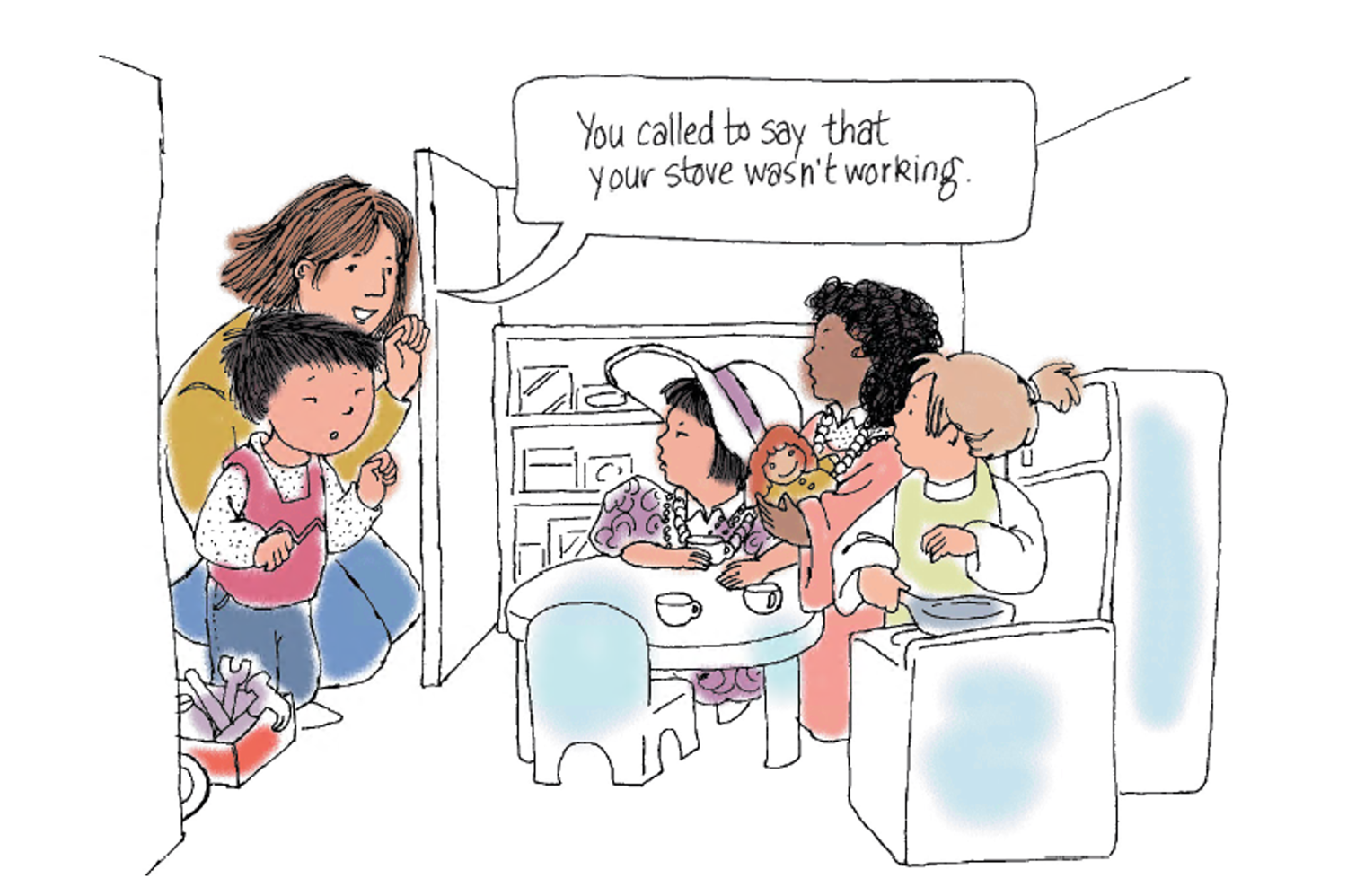Two Tips for Helping Children Pretend Together

There’s a good reason why play is considered children’s work, especially when it comes to pretend play. When children pretend, they practice so many skills, such as communication and thinking skills. And when children pretend with other children – known as “social pretend play” – they have an opportunity to practice even more skills, including:
- advanced ways of using language that help them succeed in school – such as language used to make plans, predict the future, give explanations, and analyze situations [1]
- social skills – such as discussing and solving problems together, taking turns, and understanding each other’s point of view [2]
It’s no wonder experts consider social pretend play to be an important part of children’s development [3].
Children usually start to pretend by the time they are two years old. But their ability to pretend with other children develops later, between ages three to five [4]. While not all children are outgoing, most children form friendships with their peers by the age of three and can have short interactions with them [1].
Just like most other skills, children’s ability to pretend with other children doesn’t happen overnight. When children begin to pretend together, they may only do a few simple pretend actions while sharing materials, such as cutting and serving toy food. Their play may not involve complicated roles and they may not tell each other what they are doing or make plans together. But with more practice, their social pretend skills become more advanced – they learn to take on more pretend roles, they plan the play together (“You be the shopper and I’ll be the cashier.”), use language to pretend (“Excuse me, do you have any apples for sale?”), and use objects in more imaginative ways (“Let’s pretend this rope is a snake.”).
Whether you are a parent or you work with young children, there are two simple things you can do to help children pretend together:
Give them toys and materials for pretending
It’s important to provide children with toys and props that are geared towards their stage of pretend play. Children at the early stages of pretend play use realistic-looking objects and toys in their play. For example, they might hold a toy phone up to their ear, feed a doll with a miniature tea set, or fix a toy car with a screwdriver from a toy toolbox. Provide children at this stage with realistic toys, props and costumes so they can pretend about activities they have seen in their everyday life, like cooking, going to the grocery store, eating at a restaurant, or going to the doctor.
It’s important to provide children with toys and props that are geared towards their stage of pretend play.
Eventually, children can use less realistic props and open-ended objects to pretend. Their play becomes more advanced and they are able to pretend about things they haven’t experienced in real life (like pirates, princesses, or going on a spaceship) and they can use objects more flexibly when they pretend (like pretending a scarf is the flag for the pirate ship, or that a large box is a spaceship). At this stage, it’s helpful to provide children with a combination of realistic and open-ended materials to stimulate their imagination. Examples of open-ended materials include boxes of different sizes, toilet paper rolls, paper towel rolls, empty milk cartons, and blocks.
Join in the play yourself!
Researchers have found that the best way to encourage children to pretend together is to join in with them while they play [3]. Joining in the play means taking on a role yourself and being a play partner for the children. There are a few important things you can do when you join in the play:
- Follow the children’s lead – Allowing the children to lead the pretending lets them practice using their imagination and language skills.They will be more motivated to play together when they are in charge of the theme and main ideas. Try to wait before you join in and say something. Think of yourself as their play partner rather than a play teacher.
- Play like a child – Observe the things the children are doing and saying and find a pretend role for yourself based on whatever theme they’ve come up with. If they are playing restaurant, you could ask them if they need a waiter. If they are playing hospital, you can pretend to have a broken leg. Try to say things your character would say, instead of speaking from your own perspective. For example, instead of saying “Maybe you can pretend to cook me some dinner?”, pretend you are a customer and ask, “Does the chef have any specials tonight?”
- Add some new ideas to expand the pretending – While staying in character, you can add new ideas once in a while to keep the play going and expand the children’s thinking. For example, if you are the customer at the pretend restaurant, you can ask the waiter if there are any “appetizers”, if you can pay with your“credit card”, or whether they have a “take out service”. Introducing new words and ideas stimulates children’s language skills but also adds to the pretending (e.g., it encourages the children to cook appetizers, look for a credit card machine, or find takeout boxes to pack up your dinner). Just be sure to let the children lead most of the play, only adding ideas based on their theme once in awhile to enrich the play or keep the interaction going.
Be sure to let the children lead most of the play.
- Encourage interaction – If a child is having trouble participating, you can encourage interaction by finding a role or action for the child. For example, if the children are pretending to be doctors and patients at a hospital and Evelyn is having trouble joining in, you can say “I hear Dr. Evelyn is an excellent surgeon. Maybe we should ask her to help us fix Grace’s arm?” In this way, you suggest a role for the child but stay in role yourself, which doesn’t disrupt the pretending. Here’s another example from Hanen’s Learning Language and Loving It™ guidebook for educators:

In this example, Liam’s teacher helps him join some other children who are pretending in the kitchen area. After pretending to knock on the door, the teacher finds a role for Liam (stove repair) while joining in the pretending herself (she talks to the children as if she works for the stove repair company and received their phone call). Not only does this help Liam join in with the children, but it adds on to the pretend theme which will expand the children’s play.
If you are a parent who is concerned about your child’s ability to play with peers, talk to your child’s teacher or a speech language pathologist. If you would like to learn more about how to help young children learn to pretend, we have some other articles which may be of interest to you:
- The Land of Make Believe: How and Why to Encourage Pretend Play
- Toys That Kick-start the Imagination!
- Encouraging Pretend Play in Children with Social Communication Difficulties
- Pretend Play Should Be Fun, Not Work!
If you are an early childhood educator and would like to learn more about how to encourage children’s pretend play, as well as how to promote their language, social, and literacy skills in the classroom, you can find out more about Hanen’s Learning Language and Loving It™ resources here.
